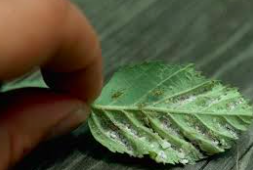Maryland Native Plant Gardens: Bring on the Bugs!
- Nuts for Natives
- Aug 9, 2023
- 2 min read
You are creating an ecosystem.

We all have been taught to watch out for bug damage. In a garden with native plants, it is just the opposite! Once you have bugs, you will know you are well on your way to recreating the ecosystem once there.
If you see signs bugs have been about, it's a very good thing. In all likelihood, you have succeeded in providing a web of food that will sustain creatures right up the food chain. At any time in your native plant garden, bugs are there. In August, they can become really apparent as the buffet table you have created has been set for a while. It can take some getting used to. Tattered leaves, clusters of bugs --oooh!
Every year, once new spring growth on our river birch (Betula nigra) emerges, at least a third of the tender leaves begin to curl and yellow. It's aphids. They like the fresh new growth. A few days later, ladybugs arrive to eat the aphids. Those leaves that are most damaged drop off and by the time summer is in full swing, new leaves have taken their place. Happens every year.
Maypop vine (Passiflora incarnata) is native from Florida to Maryland. A relative growing maypop in Florida a few years back saw his maypop vine covered in caterpillars. They completely defoliated the vine. Reasonably thinking it would die, he dug out the remaining part of the plant and replaced it. In Florida, maypop vine is a larval host to several butterflies. Those caterpillars may have been from one of those butterflies. We will never know for sure. But what about complete defoliation? Can a plant come back from that? Scientists say when the plant has been consumed by a caterpillar for which it is host, those two have been in relationship for tens of thousands of years. Some years, for a variety of reasons, a particular insect may have a banner year and its population is unusually large. The plant, having co-evolved with that insect, can handle it and come back.
If you grow milkweed, you may likely soon see milkweed bugs. Like monarchs, they too feed on milkweed and scientists say do no harm. This is not to say there are not "bad" bugs. Bugs like the invasive spotted lanternfly and emerald ash borer can destroy on a very large scale.
For the most part though, leaving bugs be invites in their predators and before you realize it, those bugs are gone and something else has arrived. Another big upside to this approach? Less work and less cost!

At the end of the day, when you look at the big picture, everything seems alright!






































Comments